Biotechnology
1/39
There's no tags or description
Looks like no tags are added yet.
Name | Mastery | Learn | Test | Matching | Spaced |
|---|
No study sessions yet.
40 Terms
Recombinant DNA technology
Procedures used to produce recombinant DNA; involves introducing DNA into a cell from a different type of organism or modified DNA to produce a transgenic organism.
Benefit with replacing faulty genes with good ones (gene therapy) and the production of synthetic hormones.
Restriction enzymes
Enzymes used to cut out a section of DNA at a specific sequence of nucleotides - recognition site. Produce either a straight or staggered cut.
Straight Cut
A clean break is made that results in a blunt end. Both ends end with a base pair.
Staggered cut
Results in sticky ends - a stretch of unpaired nucleotides in the DNA molecule that overhang at the break in the strands. They allow it to combine with other sections of DNA that have a complementary pairing.
DNA Ligase
The enzyme that can join separate pieces of DNA.
Ligation
The process of joining short strands of DNA during replication.
Steps to produce an organism with recombinant DNA
1) Restriction enzymes
2) Vectors
3) Splice
4) Transformation
5) Reproduction
Real Vikings Sail Toward Riches
Steps 1 to produce an organism with recombinant DNA
Restriction enzymes
The gene of interest is isolated and cut out using a restriction enzyme by a staggered cut. This produces a fragment with overhanging “sticky end”
Steps 2 to produce an organism with recombinant DNA
Vectors
Insert the gene into a vector
A plasmid from a bacterial cell is isolated and cut with the same type of restriction enzyme to create a plasmid with sticky ends complementary to the DNA of interest.

Vectors
A carrier DNA molecule into which other DNA can be inserted. Bacteria have circular pieces of DNA called plasmids which can replicate within the cell independent of the chromosomal DNA.
Steps 3 to produce an organism with recombinant DNA
Splice
Splice/ Join the fragment of DNA(target gene) into the plasmid using DNA ligase to join the sticky ends
Steps 4 to produce an organism with recombinant DNA
Transformation
Plasmids can be introduced into bacteria, such as E. coli in labs, in a process called transformation.
Specially prepared bacterial cells are given a shock (such as high temperature) that encourages them to take up the plasmid with the foreign DNA.
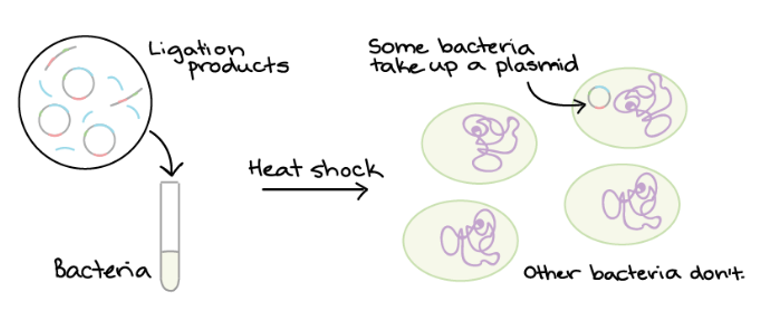
Steps 5 to produce an organism with recombinant DNA
Reproduction
Bacteria carrying the plasmid reproduce to give rise to a small colony of identical bacteria that all carry the plasmid.
The bacteria uses the instructions of the inserted DNA to make human hormones or vaccines. The protein is purified before it is used
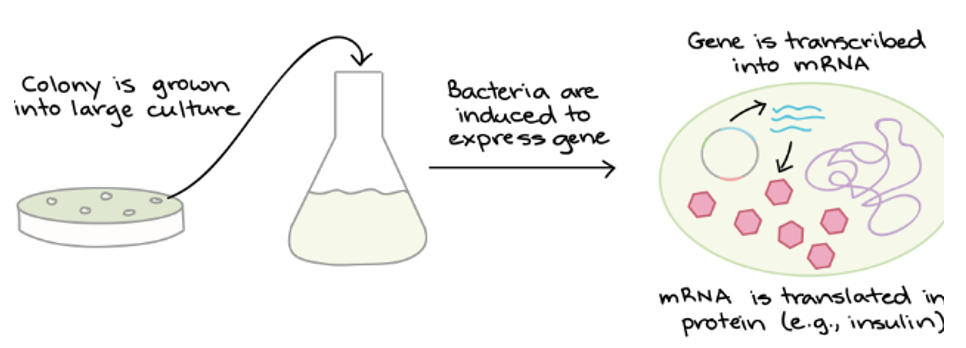
Biotechnology
The manipulation of living things to produce useful products.
DNA is made up of nucleotides which are composed of a sugar, phosphate and a nitrogenous base.
The order in which the bases occur is the genetic code as it determines what proteins a cell will produce which determines the structure of a cell and how it functions.
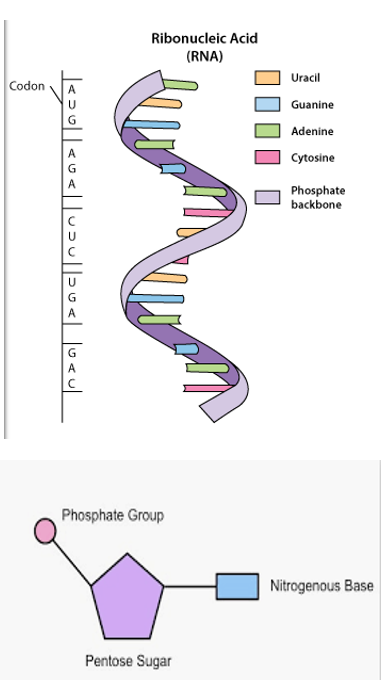
Current applications of biotechnology
Identification, Treatment and Prevention of Diseases
Improved Understanding of Human Evolution and Migration
Forensic science (human identification)
Forensic science (plant and animal identification)
Identification, Treatment and Prevention of Diseases
The HGP has identified over 4000 genetic diseases. Genetic tests have been developed which check for faulty genes. E.g. Huntington’s disease.
Leads to earlier detection of diseases and the potential in the future to carry out gene therapy to replace faulty genes with healthy ones.
In the future, pharmacogenomics "custom drugs" – drugs personalized to an individual’s genetic needs
Improved Understanding of Human Evolution and Migration
Study evolution through germline mutations in lineages. Study migration of different population groups based on female genetic inheritance.
It provides insights into the genetic basis of adaptation, speciation, disease, and conservation, with practical applications in various fields including medicine, agriculture, and conservation biology.
Forensic science (human identification)
Comparing two samples of DNA to identify individuals. Identifying suspects whose DNA may match evidence crime scenes. Identifying crime and catastrophe victims. Establishing paternity and other family relationships.
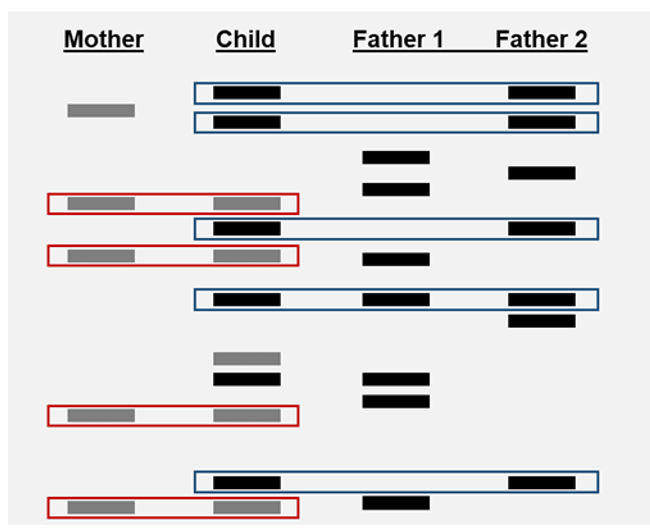
Forensic science (plant and animal identification)
Comparing two samples of DNA
Identify endangered and protected species as an aid to wildlife officials (could be used for prosecuting poachers). Authenticate consumables such as caviar, wine and fish
Ethical concerns when accessing personal genetic information
Confidentiality
Equity
Privacy
Autonomy
Commercialisation of products
Confidentiality
There should be limited access to and sharing of an individual’s personal genomic information. A patients' genetics information should not be shared without the patient's consent, unless required by law.
Equity
Fair treatment based on genomic information by insurers, employers, courts, schools, adoption agencies, military etc. Equal access to testing, expensive so not accessible to all.
Privacy
Individuals need to consider possible information that may be revealed (unknown genetic relationships/ inheritance of disease). Potential distress/harm caused by revealing such information.
Autonomy
The right of persons to make an informed, independent judgment about whether they wish to be tested and then whether they wish to know the details of the outcome.
Commercialisation of products
Should property rights (patents, copyrights eg breast cancer gene) be able to be applied to genetic data
USES OF RECOMBINANT DNA TECHNOLOGY
Producing human insulin
Vaccines
Producing Human Insulin
1. mRNA is extracted from human pancreatic tissue and is used to make a double strand of DNA from which the human insulin gene can be identified.
2. The human insulin gene is removed using a restriction enzyme.
3. A plasmid from a bacteria is cut using the same restriction enzyme producing complementary sticky ends to the DNA containing the human insulin gene.
4. The DNA containing the insulin gene is inserted into the plasmid using DNA ligase.
5. The plasmid containing the gene for human insulin is taken up by bacteria. Bacteria multiply.
6. The bacteria transcribe and translate the information of the human gene which results in the production of insulin.
7. The insulin is purified creating is a reliable, uncontaminated supply of human insulin.
Vaccines
A DNA sequence from a pathogen is inserted into a harmless bacteria. A vaccine which contains the modified bacteria is injected. The DNA sequence causes the production of antibodies which results in immunity against the pathogen but doesn’t cause the disease.
Hepatitis B (HB) Vaccine
HB antigen producing gene is isolated from HB virus and removed using a restriction enzyme producing sticky ends.
1. A plasmid is extracted from a bacterium and cut with the same restriction enzyme to produce complementary sticky ends
2. The HB antigen producing gene is inserted into the bacterial plasmid using DNA ligase forming the recombinant DNA.
3. This recombinant DNA is introduced into a yeast cell which reproduces and begins producing HB antigens
4. The HB antigens are extracted, purified and bottled ready to be used to vaccinate humans
Gel Electrophoresis
A technique that can separate DNA strands based on their lengths.
The DNA pieces are placed in wells in a semi-solid gel that is immersed in a salt-containing buffer solution that can conduct electricity. The end of the gel with the wells is positioned towards the negative electrode and the end without wells (towards which the DNA fragments will migrate) is positioned towards the positive electrode. When an electric current is passed through the gel, the negatively charged DNA moves towards the positive electrode. The smaller DNA pieces move faster than the larger ones.
DNA profile / DNA fingerprint
Electrophoresis results in a pattern of bands. This banding pattern is an individual’s DNA profile / DNA fingerprint.
DNA Ladder
The first well may contain a control DNA sample of known length (ladder). The results from the unknown samples are compared to the ladder to determine the length of the DNA strands in the sample.
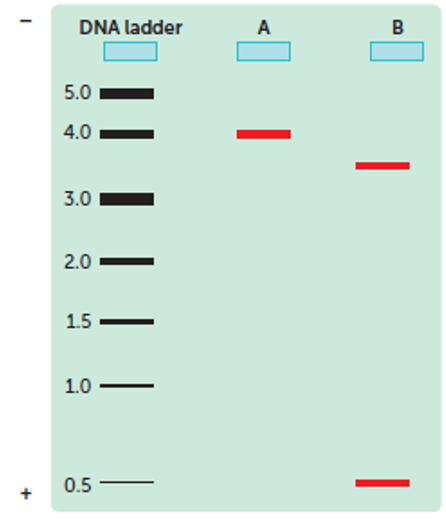
DNA Sequencing
The determination of the precise order of nucleotides in a sample of DNA
Since the human genome contains so much information you can’t analyse it all at once. DNA is broken into smaller pieces, and a sequencer is used to determine the order of the nucleotides in each of these fragments. Then, bioinformatic technology (a computer program) puts all the pieces back together so that they can be analysed.
Can identify mutations or compare DNA from different organism
Allows a sequence of DNA to be compared ->Detect changes in alleles -> Point mutations, insertions and deletions
polymerase chain reaction
If only a small amount of DNA is available, PCR has allowed small quantities of DNA replicated.
Uses of PCR
To amplify tiny samples of DNA from fossils of extinct species
-For information on relatedness of species and migration information
To shorten the time to detect hereditary diseases.
-Sections of DNA is amplified to recognize faulty DNA that causes genetic diseases
Early detection of infectious diseases.
-Samples are taken and tested for foreign DNA from viruses or bacteria
DNA profiling
-Comparing an individual’s DNA to a library of DNA from known individuals
Steps in PCR
PCR mimics DNA replication.
Denaturing
Annealing
Extension/Elongation
PCR step 1
Denaturing
The two strands of DNA are separated by heating to 96oC
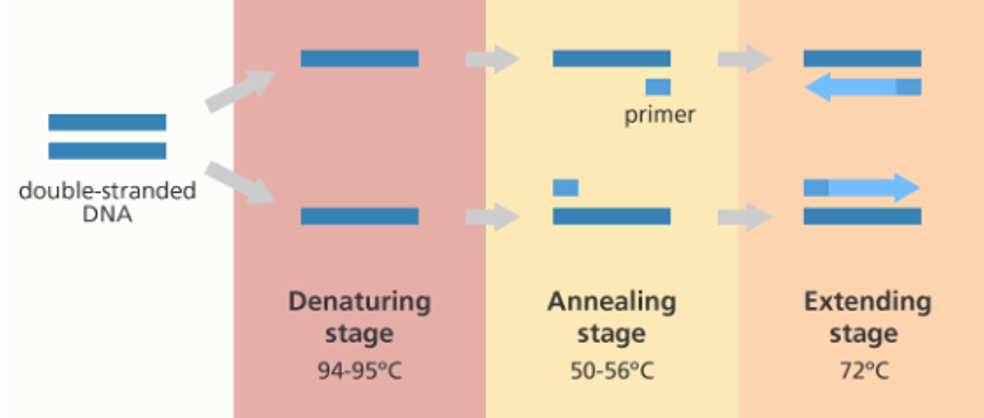
PCR step 2
Annealing
Short sections of DNA (primers) are bound to the separated strands once the DNA has been cooled to 55-65oC.

PCR step 3
Extension/Elongation:
PCR only amplifies a certain region of the DNA, not the whole template. The primers act as a starting point for Taq polymerase (a heat stable DNA polymerase) to start adding complementary DNA nucleotides. The original sample is doubled and the process repeated ~20–30 times and results in compounding amplification - chain reaction. It takes 2-3 hours to produce about a billion copies.
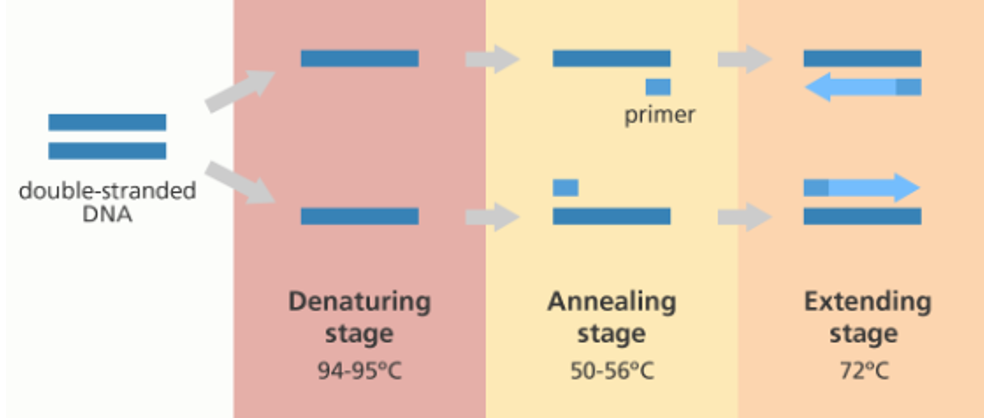
What could be done with the information obtained by gel electrophoresis to help study evolutionary relationships
Organisms with more similar banding patterns have more similar DNA, suggesting a closer evolutionary relationship.
Show variation within a species or between closely related species, providing insight into how speciation occurs.
It may be difficult to classify a newly discovered organism as a separate species.
- some species can interbreed and produce fertile offspring.
- species are evolving over time
-there is variation within a species